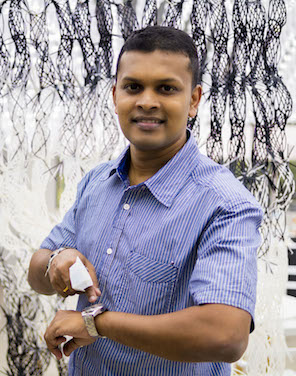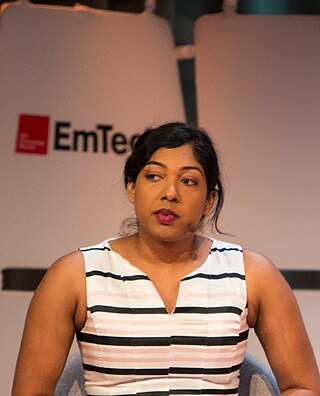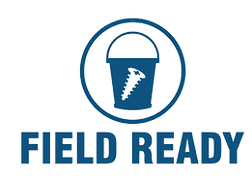The Engineering and Physical Sciences Research Council (EPSRC) is a British Research Council that provides government funding for grants to undertake research and postgraduate degrees in engineering and the physical sciences, mainly to universities in the United Kingdom. EPSRC research areas include mathematics, physics, chemistry, artificial intelligence and computer science, but exclude particle physics, nuclear physics, space science and astronomy. Since 2018 it has been part of UK Research and Innovation, which is funded through the Department for Business, Energy and Industrial Strategy.
The Innovators Under 35 is a peer-reviewed annual award and listicle published by MIT Technology Review magazine, naming the world's top 35 innovators under the age of 35.
Health technology is defined by the World Health Organization as the "application of organized knowledge and skills in the form of devices, medicines, vaccines, procedures, and systems developed to solve a health problem and improve quality of lives". This includes pharmaceuticals, devices, procedures, and organizational systems used in the healthcare industry, as well as computer-supported information systems. In the United States, these technologies involve standardized physical objects, as well as traditional and designed social means and methods to treat or care for patients.
Daniel John DiLorenzo is a medical device entrepreneur and physician-scientist. He is the inventor of several technologies for the treatment of neurological disease and is the founder of several companies which are developing technologies to treat epilepsy and other medical diseases and improve the quality of life of afflicted patients.
Adam Ezra Cohen is a Professor of Chemistry, Chemical Biology, and Physics at Harvard University. He has received the Presidential Early Career Award for Scientists and Engineers and been selected by MIT Technology Review to the TR35 list of the world's top innovators under 35.
Trey Ideker is a professor of medicine and bioengineering at UC San Diego. He is the Director of the National Resource for Network Biology, the San Diego Center for Systems Biology, and the Cancer Cell Map Initiative. He uses genome-scale measurements to construct network models of cellular processes and disease.

Eben Christopher Upton is the Welsh CEO of Raspberry Pi Holdings. He is responsible for the overall software and hardware architecture of the Raspberry Pi device. He is a former technical director and ASIC architect for Broadcom.
BTG Limited is an international specialist healthcare company that is developing and commercialising products targeting critical care, cancer and other disorders. The current name was adopted when the British Technology Group changed its name on 27 May 1998. BTG was a constituent of the FTSE 250 Index until it was acquired by Boston Scientific in August 2019.

Suranga Nanayakkara is a Sri Lankan born computer scientist and inventor. As of 2021, he is the director of Augmented Human Lab and associate professor at the National University of Singapore. Before moving to Auckland in 2018, he was an assistant professor at Singapore University of Technology and Design. He is best known for his work on FingerReader and Haptic Chair. His research interests include Wearable Computing, Assistive Technology, Ubiquitous computing, AI, Collective intelligence and Robotics. MIT Technology Review honored Nanayakkara as one of the Innovators Under 35 for Asia Pacific Region 2014.
Jeff Hammerbacher is a data scientist. He was chief scientist and cofounder at Cloudera and later served on the faculty of the Icahn School of Medicine at Mount Sinai.

Shinjini Kundu is an Indian American physician and computer scientist at Washington University in St. Louis School of Medicine in St. Louis, Missouri. Her research focuses on designing artificial intelligence systems to detect diseases that may be imperceptible to humans. She was named one of Forbes 30 under 30, MIT Technology Review's 35 innovators under 35, a World Economic Forum Young Global Leader, and a winner of the Carnegie Science Award.
Ashutosh Saxena is an Indian-American computer scientist, researcher, and entrepreneur known for his contributions to the field of artificial intelligence and large-scale robot learning. His interests include building enterprise AI agents and embodied AI. Saxena is the co-founder and CEO of Caspar.AI, where generative AI parses data from ambient 3D radar sensors to predict 20+ health & wellness markers for pro-active patient care. Prior to Caspar.AI, Ashutosh co-founded Cognical Katapult, which provides a no credit required alternative to traditional financing for online and omni-channel retail. Before Katapult, Saxena was an assistant professor in the Computer Science Department and faculty director of the RoboBrain Project at Cornell University.
Madhu Bhaskaran is an Indian engineer and Professor at RMIT University. She co-leads the Functional Materials and Microsystems Research Group at RMIT University She won the APEC Aspire prize in 2018 for her development of "electronic skin".

Julia Rosolovsky Greer is a materials scientist and is the Ruben F. and Donna Mettler Professor of Materials Science, Mechanics and Medical Engineering at the California Institute of Technology (Caltech). As of 2019, Greer is also the director of the Kavli Nanoscience Institute at Caltech.

BETIC based at Indian Institute of Technology Bombay is an inter-disciplinary multi-institution initiative for medical device innovation. Established in 2014 with support from the government of Maharashtra, it comprises a network of 14 engineering and medical institutes across the state. The BETIC team have developed 50 medical devices as of 2019, and licensed 20 of them to startup companies or industry for mass production.

Isaac Sesi is a Ghanaian entrepreneur, engineer, and the founder of Sesi Technologies, a Ghanaian company that solves agricultural and food challenges. He is known for his development of a moisture meter to help sub-Saharan African farmers reduce post-harvest losses
Ida Pavlichenko is an Azerbaijani biomedical engineer and a Technology Development Fellow at the Harvard University Wyss Institute for Biologically Inspired Engineering. Pavlichenko is the co-founder and chief executive officer of PionEar Technologies, a medical device company that develops intelligent technologies for treating ear and hearing disorders. The tympanostomy technology she invented for treated recurrent ear infections has been nationally recognized for its innovative design which addresses many of the limitations of current ear tubes.

Rohit Srivastava is a Himanshu Patel Chair Professor in the Department of Biosciences and Bioegineering at IIT Bombay specialising in medical diagnostic devices, nanoengineered materials and photothermal cancer therapy. He was awarded the Shanti Swarup Bhatnagar Prize for Science and Technology in Medical Sciences in the year 2021 for his contributions to the development of affordable medical devices.

Field Ready is a non-profit, global humanitarian aid and development, non governmental organization that helps provide critical items and training to people when they are in need of them.
Ahmad Nabeel is a Kuwaiti physician, scientist, and entrepreneur.








